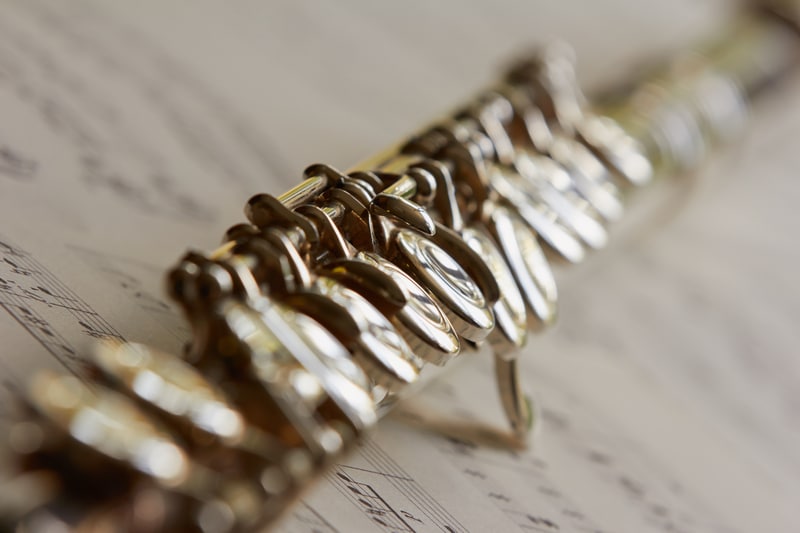
When you look at an orchestra, there are different sections: the strings, the woodwinds, the brass, and the percussion.
The woodwind section is typically situated between the strings and the brass and consists of four major instruments: flute, oboe, clarinet, and bassoon (although several additional auxiliary instruments related to these four exist).
Of these four, however, there is clearly an anomaly. Oboes, clarinets, and bassoons are all reed instruments made from wood, whereas the flute does not use a reed to produce sound and is typically made from metal.
The only thing it seems to have in common with the other members of its section is that it is played by blowing air through it – but brass instruments do this as well. So why is the flute part of the woodwind section rather than the brass or its own family entirely?
Why Is The Flute A Woodwind?
The Wood Flute
Believe it or not, the metal version of the flute is actually a fairly recent invention. The flute has been around since prehistoric times. It is older than any other instrument, besides the human voice and possibly some type of percussion.
These original flutes were made from animal bone, though many ancient flutes found slightly later in China in India were made from bamboo. Over time, however, wood became the most popular material for flutes.
The transverse flutes that were played in Europe in the Middle Ages, the closest predecessors to the modern flute, were primarily made of wood, and this tradition carried well into the Baroque and Classical periods.
Flutes did not begin to be made from metal until Theobald Boehm invented the Boehm flute in 1847. However, it was not an immediate switch; most flutists preferred to play on wood instruments that had adapted to the Boehm system.
Metal flutes did not become the norm until well into the twentieth century. Today, some flutes are still made of wood. Typically, these flutes are most commonly seen in performances of period music (such as Renaissance or Baroque) or folk music.
Nonetheless, a few professional orchestral flutists still have a personal preference for wood.
Why Did Wood Flutes Lose Popularity?
Wood flutes are beautiful instruments. Those who continue to play them today might even argue that they have richer, more alluring sound than the metal flutes they have been replaced by. So when Boehm created his new and improved flute system, why did he change to metal?
Flutes had to keep up with the changing times. Just as the flute was evolving, orchestras were evolving too. The beginnings of the modern orchestra date back to about 1600, when Monteverdi premiered his opera Orfeo with orchestral accompaniment.
However, the size and scale of the orchestra quickly grew. By the late 1800s, the orchestra had grown to nearly full size, and incorporated the instruments we associate with the orchestra today – including woodwinds, brass, percussion, and auxiliary instruments (in addition to the traditional strings).
Because of the size of the new orchestra, flutes had to project more. Unfortunately, though wood flutes produced a beautiful sound, they just couldn’t be heard well enough over the powerful new orchestra, especially in the back of the hall.
In particular, the low register suffered. Additionally, wood flutes didn’t have many keys, if any, which made technique much more difficult. The intonation was also challenging; the chromatic notes were not evenly spaced and thus had to constantly be adjusted.
Flutes were rapidly being surpassed by other instruments that had a greater virtuosic, technical, and expressive range.
If Boehm (or someone else) had not adjusted and improved the flute to allow it to play louder with a greater quality of sound and with better technique, it likely would not be kept in the orchestral setup.
Woodwind Sections and Quintets
Although the metal flute is different from its fellow woodwind instruments, the woodwind section has adapted.
Each section of the orchestra functions as sort of a large chamber group, which means the individual instruments must be in tune with each other and work together to create music.
In a string or brass section, this is easy, because all of the instruments are played the same way and made from similar material, they just vary in size. In a woodwind section, this can be a challenge, because the instruments are so different.
However, this also gives the woodwind section an advantage – they can create unique timbres and sound colors that cannot be produced by homogeneous instruments. Blending a flute sound with a clarinet or oboe sound can be an exciting endeavor, and once it happens, the sound can be magical.
In fact, composers have come to enjoy the blend of a woodwind section so much that they started writing music for a specific chamber group called the woodwind quintet. Luckily, in this chamber ensemble of five, the flute is not the only outlier.
The french horn, typically a brass instrument, joins the woodwind section to complete this group. Like in the orchestra, there are still some challenges associated with this ensemble.
For instance, the french horn often has to play much quieter than normal in order to balance, the french horn and the flute must work to blend their sounds with the other wood instruments, and vibrato must be adjusted to account for the fact that the clarinet and horn generally do not use much.
Nevertheless, famous composers such as Ibert, Reicha, Taffanel, Nielsen, Piston, Milhaud, Hindemith, Carter, Françaix, and many others have been able to capture the personalities of the different instruments so well in their music that it somehow works.
Although the flute sometimes sticks out in a woodwind section, that doesn’t have to be a bad thing. The flute sounds like no other instrument in the orchestra, making it particularly special.
Composers have learned how to best incorporate it into their music, and when a blend is necessary, it can also be easily adapted to match other instruments. The wood flute is also not gone; it still has an important role in music and in history.


